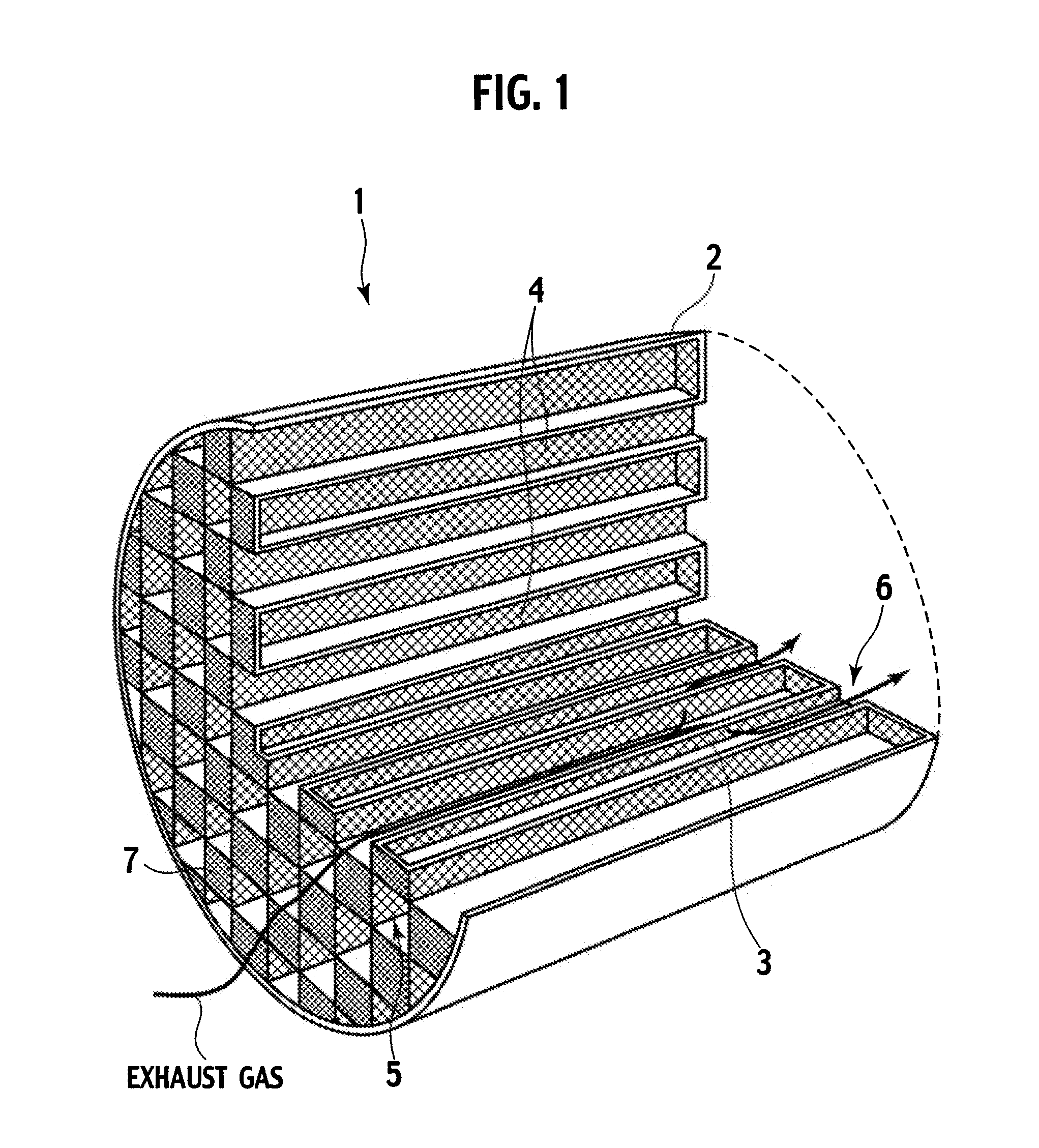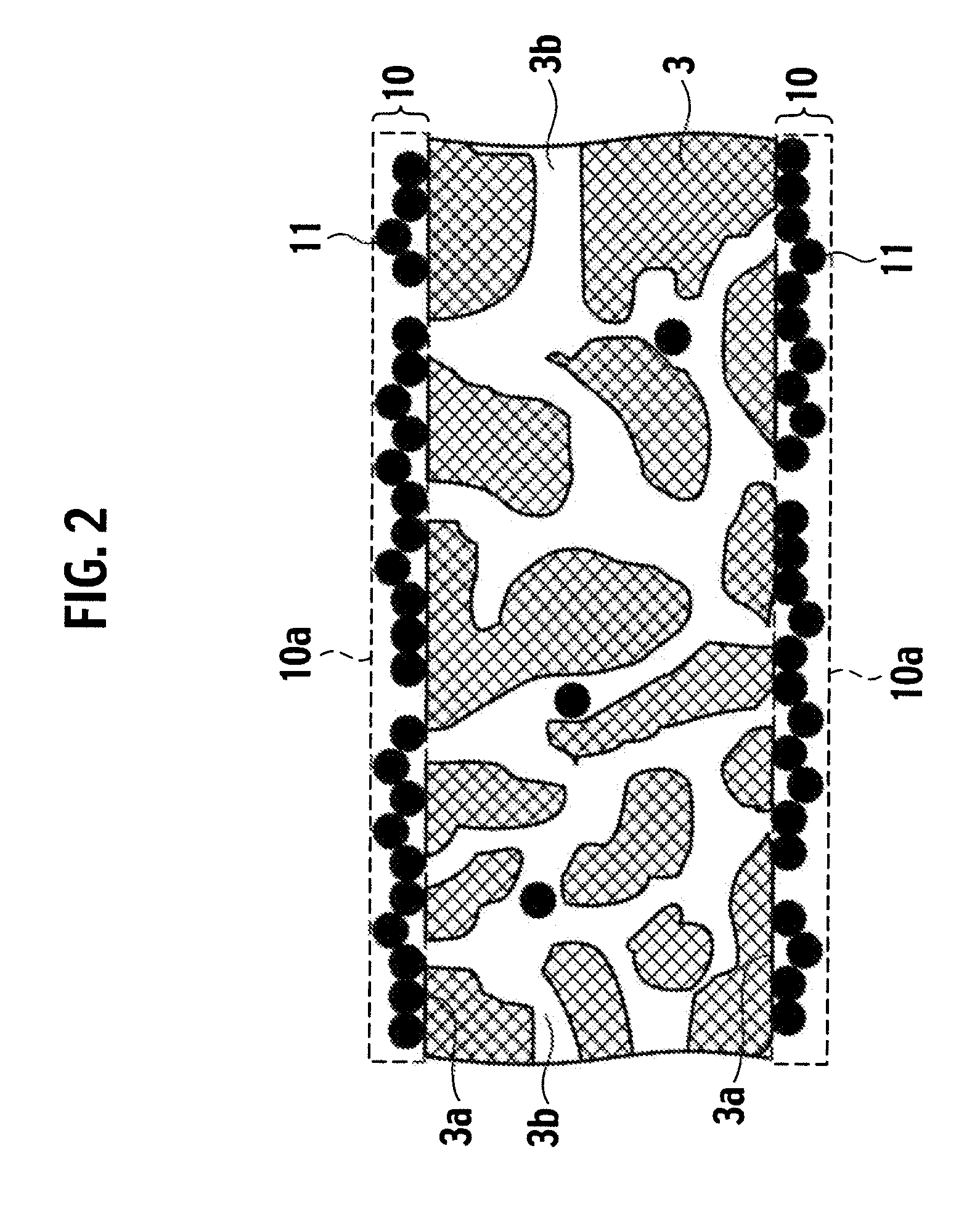Catalytic converter and manufacturing method thereof
a technology of catalytic converter and manufacturing method, which is applied in the direction of physical/chemical process catalyst, metal/metal-oxide/metal-hydroxide catalyst, separation process, etc., can solve the problem that the catalytic function cannot be fully exerted
- Summary
- Abstract
- Description
- Claims
- Application Information
AI Technical Summary
Benefits of technology
Problems solved by technology
Method used
Image
Examples
example 1
[0038]450 g of cerium oxide powder, 125 g of activated carbon, and 50 g of alumina sol were mixed into 2000 g of water, followed by stirring, whereby a catalyst slurry was prepared.
[0039]Next, a SiC-made honeycomb support was prepared, in which a diameter was 144 mm, a height was 152 mm, a cell density was 400 / in2, a center pore diameter in the cell wall was 10 to 20 μm, and porosity was 50 to 60 vol %. This honeycomb support was immersed into the above-described catalyst slurry, and excessive catalyst slurry was then removed therefrom, followed by drying at 150° C. for two hours and baking at 400° C. for four hours. In such a way, a catalyst layer was formed on the honeycomb support, and a catalytic converter of this Example was obtained. A formed amount of the catalyst layer was 50 g per liter of the catalytic converter.
[0040]FIG. 5 shows the SEM picture of a vicinity of the corner of the honeycomb in the catalytic converter of this Example. From FIG. 5, the following is understoo...
example 2
[0042]450 g of cerium / praseodymium composite oxide powder, 125 g of activated carbon, and 50 g of alumina sol were mixed into 2000 g of water, followed by stirring, whereby a catalyst slurry was prepared.
[0043]Next, the SiC-made honeycomb support used in Example 1 was prepared, and was immersed into the catalyst slurry, and excessive catalyst slurry was then removed therefrom, followed by drying at 150° C. for two hours and baking at 400° C. for four hours. In such a way, a catalyst layer was formed on the honeycomb support, and a catalytic converter of this Example was obtained. A formed amount of the catalyst layer was 50 g per liter of the catalytic converter. 82% of the total supported amount of the catalyst component was coated on the surface of the support.
example 3
[0044]450 g of cerium / yttrium composite oxide powder, 125 g of activated carbon, and 50 g of alumina sol were mixed into 2000 g of water, followed by stirring, whereby a catalyst slurry was prepared.
[0045]Next, the SiC-made honeycomb support used in Example 1 was prepared, and was immersed into the catalyst slurry, and excessive catalyst slurry was then removed therefrom, followed by drying at 150° C. for two hours and baking at 400° C. for four hours. In such a way, a catalyst layer was formed on the honeycomb support, and a catalytic converter of this Example was obtained. A formed amount of the catalyst layer was 50 g per liter of the catalytic converter. 82% of the total supported amount of the catalyst component was coated on the surface of the support.
PUM
| Property | Measurement | Unit |
|---|---|---|
| pore diameter | aaaaa | aaaaa |
| particle diameter | aaaaa | aaaaa |
| pore diameter | aaaaa | aaaaa |
Abstract
Description
Claims
Application Information
 Login to View More
Login to View More - R&D
- Intellectual Property
- Life Sciences
- Materials
- Tech Scout
- Unparalleled Data Quality
- Higher Quality Content
- 60% Fewer Hallucinations
Browse by: Latest US Patents, China's latest patents, Technical Efficacy Thesaurus, Application Domain, Technology Topic, Popular Technical Reports.
© 2025 PatSnap. All rights reserved.Legal|Privacy policy|Modern Slavery Act Transparency Statement|Sitemap|About US| Contact US: help@patsnap.com



